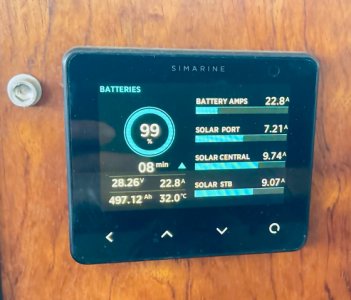geem
Well-known member
We have spent the last few years mainly in the Caribbean. Our solar used to keep our lead batteries topped up and all was fine. We swapped to lithium batteries that I built over a year ago in Antigua and we noticed a big increase in solar performance. The reason geing that the MPPTs rarely go off bulk charge so the solar works flat out.
In the Caribbean, our 920w of solar would generally produce 3 to 4kWh of power daily with the lithium batteries.
We are now in the Azores where we have long days. The Caribbean generally has circa 12 hours of sunshine summer and winter. Here we have a lot more summer sunshine hours.
The things that can influence this are solar panel temperatures. Cooler is better. Its a lot cooler here. We have 3 MPPTs and each one has hit a new peak daily output. Even though we haven't had any perfect cloud free days we have seen over 4kWh per day on several occasions.
The downside is the watermaker production has dropped from 240 litres/hr to 210litres /hr due to the cool seawater temperatures. The immersion heater needs to be on far longer as the water in the tank is cooler so needs more kw to heat it up.
The fridges are running less as the cabin temperature is far lower but they don't use much power anyway.
Overall, we have more solar power generation here than we made in the Caribbean.
In the Caribbean, our 920w of solar would generally produce 3 to 4kWh of power daily with the lithium batteries.
We are now in the Azores where we have long days. The Caribbean generally has circa 12 hours of sunshine summer and winter. Here we have a lot more summer sunshine hours.
The things that can influence this are solar panel temperatures. Cooler is better. Its a lot cooler here. We have 3 MPPTs and each one has hit a new peak daily output. Even though we haven't had any perfect cloud free days we have seen over 4kWh per day on several occasions.
The downside is the watermaker production has dropped from 240 litres/hr to 210litres /hr due to the cool seawater temperatures. The immersion heater needs to be on far longer as the water in the tank is cooler so needs more kw to heat it up.
The fridges are running less as the cabin temperature is far lower but they don't use much power anyway.
Overall, we have more solar power generation here than we made in the Caribbean.


